Advanced Neural Network-Based Equalization in Intensity-Modulated Direct-Detection Optical Systems: Current Status and Future Trends
Abstract
1. Introduction
2. Short-Reach IM/DD Systems
2.1. IM/DD System Structure
2.2. IM/DD System Model
3. Performance-Oriented NN-Based Equalizers
3.1. FNN-Based Equalizer
3.2. CNN-Based Equalizer
3.3. RNN-Based Equalizer
3.4. Cascade NN-Based Equalizer
3.5. Other Types of NN-Based Equalizers
3.6. Performance and Complexity Comparison of FNN-, L-RNN-, Cascade FNN-, and AR-RNN-Based Equalizers
3.7. Possible Pitfalls When Applying NN-Based Equalizers
4. Computationally Efficient NN-Based Equalizers
4.1. Transfer Learning
4.2. Pruning
4.3. Multi-Task Learning
4.4. Quantization
5. Conclusions and Future Perspectives
Author Contributions
Funding
Institutional Review Board Statement
Informed Consent Statement
Data Availability Statement
Conflicts of Interest
References
- Cartledge, J.; Karar, A. 100 Gb/s Intensity Modulation and Direct Detection. J. Light. Technol. 2014, 32, 2809–2814. [Google Scholar] [CrossRef]
- Chagnon, M. Optical Communications for Short Reach. J. Light. Technol. 2019, 37, 1779–1797. [Google Scholar] [CrossRef]
- Zhong, K.; Zhou, X.; Huo, J.; Yu, C.; Lu, C.; Lau, A.P.T. Digital Signal Processing for Short-Reach Optical Communications: A Review of Current Technologies and Future Trends. J. Light. Technol. 2018, 36, 377–400. [Google Scholar] [CrossRef]
- Wu, Q.; Xu, Z.; Zhu, Y.; Ji, H.; Yang, Y.; Qiao, G.; Liu, L.; Wang, S.; Liang, J.; Wei, J.; et al. Gradient-Descent Noise Whitening Techniques for Short-Reach IM-DD Optical Interconnects with Severe Bandwidth Limitation. Opt. Express 2024, 32, 1715–1727. [Google Scholar] [CrossRef]
- Xu, Z.; Sun, C.; Manton, J.; Shieh, W. Joint Equalization of Linear and Nonlinear Impairments for PAM4 Short-Reach Direct Detection Systems. IEEE Photon. Technol. Lett. 2021, 33, 425–428. [Google Scholar] [CrossRef]
- Tan, Z.; Yang, C.; Zhu, Y.; Xu, Z.; Zou, K.; Zhang, F.; Wang, Z. A 70 Gbps NRZ Optical Link Based on 850 nm Band-Limited VCSEL for Data-Center Intra-Connects. Sci. China. Info. Sci. 2018, 61, 080406. [Google Scholar] [CrossRef]
- Tan, Z.; Yang, C.; Zhu, Y.; Xu, Z.; Zou, K.; Zhang, F.; Wang, Z. High speed band-limited 850-nm VCSEL link based on time-domain interference elimination. IEEE Photon. Technol. Lett. 2017, 29, 751–754. [Google Scholar] [CrossRef]
- Lu, W.; Liu, Z.; Xu, Z.; Liu, L.; Zou, Y.; Dai, X.; Yang, Q.; Shieh, W. Impact of Non-Gaussian Noise on GMI and LDPC Performance in Neural Network Equalized Systems. Opt. Lett. 2024, 49, 923–926. [Google Scholar] [CrossRef]
- Zhou, J.; Qiao, Y.; Huang, X.; Yu, C.; Cheng, Q.; Tang, X.; Guo, M.; Liu, W.; Li, Z. Joint FDE and MLSD algorithm for 56-Gbit/s optical FTN-PAM4 system using 10G-class optics. J. Light. Technol. 2019, 37, 3343–3350. [Google Scholar] [CrossRef]
- Zhong, K.; Zhou, X.; Wang, Y.; Gui, T.; Yang, Y.; Yuan, J.; Wang, L.; Chen, W.; Zhang, H.; Man, J.; et al. Recent Advances in Short Reach Systems. In Proceedings of the Optical Fiber Communication Conference (OFC), Los Angeles, CA, USA, 19–23 March 2017. [Google Scholar]
- Wu, Q.; Xu, Z.; Zhu, Y.; Ji, H.; Yang, Y.; Liang, J.; Qiao, G.; Wang, S.; Liu, L.; Wei, J.; et al. 405-GBd OOK and 201-GBd PAM-4 IM/DD Optics at Record Faster-Than-Nyquist Ratios of 226.6% and 62.1% Enabled by Advanced Noise Whitening. In Proceedings of the Asia Communications and Photonics Conference (ACP), Wuhan, China, 4–7 November 2023; pp. 1–4. [Google Scholar]
- Xu, X.; Zhou, E.; Liu, G.N.; Zuo, T.; Zhong, Q.; Zhang, L.; Bao, Y.; Zhang, X.; Li, J.; Li, Z. Advanced Modulation Formats for 400-Gbps Short-Reach Optical Inter-Connection. Opt. Express 2015, 1, 492–500. [Google Scholar] [CrossRef]
- Shi, J.; Zhang, J.; Li, X.; Chi, N.; Chang, G.; Yu, J. 112 Gb/s/λ CAP Signals Transmission over 480 km in IM-DD System. In Proceedings of the Optical Fiber Communications Conference (OFC), San Diego, CA, USA, 11–15 March 2018. [Google Scholar]
- Yekani, A.; Rusch, L.A. Interplay of Bit Rate, Linewidth, Bandwidth, and Reach on Optical DMT and PAM with IMDD. IEEE Trans. Commun. 2019, 4, 2908–2913. [Google Scholar] [CrossRef]
- Wu, Q.; Xu, Z.; Zhu, Y.; Ji, T.; Ji, H.; Yang, Y.; Liang, J.; Cheng, C.; Qiao, G.; He, Z.; et al. Beyond 200-Gb/s O-band Intensity Modulation and Direct Detection Optics with Joint Look-Up-Table-Based Predistortion and Digital Resolution Enhancement for Low-Cost Data Center Interconnects. Adv. Photon. Nexus 2024, 3, 036007. [Google Scholar] [CrossRef]
- Liu, N.; Xiao, J.; Liu, C.; Shen, G. IM/DD transmission for Data Center Optical Interconnects. In Proceedings of the Asia Communications and Photonics Conference (ACP), Shanghai, China, 24–27 October 2021. [Google Scholar]
- Jiang, L.; Yan, L.; Yi, A.; Pan, Y.; Zhang, B.; Hu, Q.; Pan, W.; Luo, B. Integrated Components and Solutions for High-Speed Short-Reach Data Transmission. Photonics 2021, 8, 77. [Google Scholar] [CrossRef]
- Wu, Q.; Xu, Z.; Zhu, Y.; Ji, H.; Yang, Y.; Liang, J.; Ji, T.; Qiao, G.; Wang, S.; Liu, L.; et al. Dispersion-Unmanaged Transmission of 144-Gb/s PAM-8 and 110-Gb/s PAM-6 Signals Over 10/20-km SSMF for DML-Based IM-DD Optics at C Band. In Proceedings of the Optical Fiber Communication Conference (OFC), San Diego, CA, USA, 24–28 March 2024. [Google Scholar]
- Wu, Q.; Xu, Z.; Zhu, Y.; Ji, T.; Ji, H.; Yang, Y.; Qiao, G.; Cheng, C.; Tang, J.; Zhao, T.; et al. High-Speed Dispersion-Unmanaged DML-Based IM-DD Optics at C-band with Advanced Nonlinear Equalization and Noise Whitening. J. Light. Technol. 2024, 42, 5591–5598. [Google Scholar] [CrossRef]
- Gao, Y.; Cartledge, J.C.; Yam, S.S.H.; Rezania, A.; Matsui, Y. 112 Gb/s PAM-4 Using a Directly Modulated Laser with Linear Pre-Compensation and Nonlinear Post-Compensation. In Proceedings of the European Conference and Exhibition on Optical Communication (ECOC), Dusseldorf, Germany, 18–22 September 2016. [Google Scholar]
- Zhang, K.; Zhuge, Q.; Xin, H.; Morsy, M.; El-Fiky, E.; Yi, L.; Hu, W.; Plant, D. Intensity Directed Equalizer for the Mitigation of DML Chirp Induced Distortion in Dispersion-Unmanaged C-band PAM Transmission. Opt. Express 2017, 23, 28123–28135. [Google Scholar] [CrossRef]
- Zhang, K.; Zhuge, Q.; Xin, H.; Hu, W.; Plant, D.V. Performance Comparison of DML, EML and MZM in Dispersion-Unmanaged Short Reach Transmissions with Digital Signal Processing. Opt. Express 2018, 26, 34288–34304. [Google Scholar] [CrossRef] [PubMed]
- Stojanovic, N.; Karinou, F.; Qiang, Z.; Prodaniuc, C. Volterra and Wiener Equalizers for Short-Reach 100G PAM-4 Applications. J. Light. Technol. 2017, 21, 4583–4594. [Google Scholar] [CrossRef]
- Watts, P.M.; Mikhailov, V.; Savory, S.; Bayvel, P.; Glick, M.; Lobel, M.; Christensen, B.; Kirkpatrick, P.; Shang, S.; Killey, R.I. Performance of single-mode fiber links using electronic feed-forward and decision feedback equalizers. IEEE Photon. Technol. Lett. 2005, 17, 2206–2208. [Google Scholar] [CrossRef]
- Wang, H.; Zhou, J.; Li, F.; Liu, L.; Yu, C.; Yi, X.; Huang, X.; Liu, W.; Li, Z. Variable-step DD-FTN algorithm for PAM8-based short-reach optical interconnects. In Proceedings of the CLEO: Science and Innovations, San Jose, CA, USA, 5–10 May 2019. [Google Scholar]
- Miao, X.; Bi, M.; Yu, J.; Li, L.; Hu, W. SVM-Modified-FFE Enabled Chirp Management for 10G DML-based 50Gb/s/λ PAM4 IM-DD PON. In Proceedings of the Optical Fiber Communications Conference (OFC), San Diego, CA, USA, 3–7 March 2019. [Google Scholar]
- Tang, X.; Liu, S.; Xu, X.; Qi, J.; Guo, M.; Zhou, J.; Qiao, Y. 50-Gb/s PAM4 over 50-km Single Mode Fiber Transmission Using Efficient Equalization Technique. In Proceedings of the Optical Fiber Communications Conference (OFC), San Diego, CA, USA, 3–7 March 2019. [Google Scholar]
- Zhou, H.; Li, Y.; Liu, Y.; Yue, L.; Gao, C.; Li, W.; Qiu, J.; Guo, H.; Hong, X.; Zuo, Y.; et al. Recent Advances in Equalization Technologies for Short-Reach Optical Links Based on PAM4 Modulation: A Review. Appl. Sci. 2019, 9, 2342. [Google Scholar] [CrossRef]
- Li, D.; Song, H.; Cheng, W.; Deng, L.; Cheng, M.; Fu, S.; Tang, M.; Liu, D. 180 Gb/s PAM8 Signal Transmission in BandwidthLimited IMDD System Enabled by Tap Coefficient Decision Directed Volterra Equalizer. IEEE Access 2020, 8, 19890–19899. [Google Scholar] [CrossRef]
- LeCun, Y.; Bengio, Y.; Hinton, G. Deep learning. Nature 2015, 521, 436–444. [Google Scholar] [CrossRef] [PubMed]
- Goodfellow, I.; Bengio, Y.; Courville, A. Deep Learning; MIT Press: London, UK, 2016. [Google Scholar]
- Bishop, C.M. Pattern Recognition and Machine Learning; Springer: New York, NY, USA, 2006. [Google Scholar]
- Schmidhuber, J. Deep learning in neural networks: An overview. Neural Netw. 2015, 61, 85–117. [Google Scholar] [CrossRef]
- Hecht-Nielsen, R. Theory of the backpropagation neural network. In Neural Networks for Perception; Academic Press: Cambridge, MA, USA, 1992; pp. 65–93. [Google Scholar]
- Duchi, J.; Hazan, E.; Singer, Y. Adaptive subgradient methods for online learning and stochastic optimization. J. Mach. Learn. Res. 2011, 12, 2121–2159. [Google Scholar]
- Kingma, D.P.; Ba, J. Adam: A method for stochastic optimization. arXiv 2014, arXiv:1412.6980. [Google Scholar]
- Raich, R.; Zhou, G.T. Orthogonal polynomials for complex Gaussian processes. IEEE Trans. Signal Process. 2004, 52, 2788–2797. [Google Scholar] [CrossRef]
- Domingos, P.M. A few useful things to know about machine learning. Commun. ACM 2012, 55, 78–87. [Google Scholar] [CrossRef]
- Han, S.; Mao, H.; Dally, W.J. Deep compression: Compressing deep neural networks with pruning, trained quantization and huffman coding. arXiv 2015, arXiv:1510.00149. [Google Scholar]
- Musumeci, F.; Rottondi, C.; Nag, A.; Macaluso, I.; Zibar, D.; Ruffini, M.; Tornatore, M. An overview on application of machine learning techniques in optical networks. IEEE Commun. Surv. Tutor. 2018, 21, 1383–1408. [Google Scholar] [CrossRef]
- Khan, F.N.; Zhou, Y.; Lau, A.P.T.; Lu, C. Modulation Format Identification in Heterogeneous Fiber-Optic Networks Using Artificial Neural Networks. Opt. Express 2012, 20, 12422–12431. [Google Scholar] [CrossRef]
- Zibar, D.; Piels, M.; Jones, R.; Schaeffer, C.G. Machine Learning Techniques in Optical Communication. J. Light. Technol. 2016, 34, 1442–1452. [Google Scholar] [CrossRef]
- Wu, X.; Jargon, J.A.; Skoog, R.A.; Paraschis, L.; Willner, A.E. Applications of Artificial Neural Networks in Optical Performance Monitoring. J. Light. Technol. 2009, 27, 3580–3589. [Google Scholar]
- Tanimura, T.; Hoshida, T.; Kato, T.; Watanabe, S.; Morikawa, H. Data-Analytics-Based Optical Performance Monitoring Technique for Optical Transport Networks. In Proceedings of the Optical Fiber Communication Conference (OFC), San Diego, CA, USA, 11–15 March 2018. [Google Scholar]
- You, Y.; Jiang, Z.; Janz, C. Machine Learning-Based EDFA Gain Model. In Proceedings of the 2018 European Conference on Optical Communication (ECOC), Rome, Italy, 23–27 September 2018. [Google Scholar]
- Morais, R.M.; Pedro, J. Machine Learning Models for Estimating Quality of Transmission in DWDM Networks. J. Opt. Commun. Netw. 2018, 10, D84–D99. [Google Scholar] [CrossRef]
- Yankov, M.; Ros, F.; Moura, U.; Carena, A.; Zibar, D. Flexible Raman Amplifier Optimization Based on Machine Learning-Aided Physical Stimulated Raman Scattering Model. J. Light. Technol. 2017, 35, 1887–1893. [Google Scholar] [CrossRef]
- Panayiotou, T.; Savva, G.; Shariati, B.; Tomkos, I.; Ellinas, G. Machine Learning for QoT Estimation of Unseen Optical Network States. In Proceedings of the Optical Fiber Communication Conference (OFC), San Diego, CA, USA, 3–7 March 2019. [Google Scholar]
- Wang, D.; Zhang, M.; Li, J.; Li, Z.; Li, J.; Song, C.; Chen, X. Intelligent Constellation Diagram Analyzer Using Convolutional Neural Network-Based Deep Learning. Opt. Express 2017, 25, 17150–17166. [Google Scholar] [CrossRef]
- Musumeci, F.; Rottondi, C.E.M.; Corani, G.; Shahkarami, S.; Cugini, F.; Tornatore, M. A Tutorial on Machine Learning for Failure Management in Optical Networks. J. Light. Technol. 2019, 37, 4125–4139. [Google Scholar] [CrossRef]
- Shahkarami, S.; Musumeci, F.; Cugini, F.; Tornatore, M. Machine-Learning-Based Soft-Failure Detection and Identification in Optical Networks. In Proceedings of the Optical Fiber Communications Conference and Exposition (OFC), San Diego, CA, USA, 11–15 March 2018; pp. 1–3. [Google Scholar]
- Khan, F.N.; Fan, Q.; Lu, C.; Lau, A.P.T. An Optical Communication’s Perspective on Machine Learning and Its Applications. J. Light. Technol. 2019, 37, 493–516. [Google Scholar] [CrossRef]
- Zhang, K.; Fan, Y.; Ye, T.; Tao, Z.; Oda, S.; Tanimura, T.; Akiyama, Y.; Hoshida, T. Fiber Nonlinear Noise-to-Signal Ratio Estimation by Machine Learning. In Proceedings of the Optical Fiber Communication Conference (OFC), San Diego, CA, USA, 3–7 March 2019. [Google Scholar]
- Schaedler, M.; Kuschnerov, M.; Pachnicke, S.; Bluemm, C.; Pittala, F.; Changsong, X. Subcarrier Power Loading for Coherent Optical OFDM Optimized by Machine Learning. In Proceedings of the Optical Fiber Communication Conference (OFC), San Diego, CA, USA, 3–7 March 2019. [Google Scholar]
- Wang, C.; Fu, S.; Xiao, Z.; Tang, M.; Liu, D. Long Short-Term Memory Neural Network (LSTM-NN) Enabled Accurate Optical Signal-to-Noise Ratio (OSNR) Monitoring. J. Light. Technol. 2019, 37, 4140–4146. [Google Scholar] [CrossRef]
- Jones, R.; Eriksson, T.; Yankov, M.; Zibar, D. Deep Learning of Geometric Constellation Shaping Including Fiber Nonlinearities. In Proceedings of the 2018 European Conference on Optical Communication (ECOC), Rome, Italy, 23–27 September 2018; pp. 1–3. [Google Scholar]
- Jones, R.; Yankov, M.; Zibar, D. End-to-end learning for GMI optimized geometric constellation shape. In Proceedings of the 2018 European Conference on Optical Communication (ECOC), Dublin, Ireland, 22–26 September 2019; pp. 1–3. [Google Scholar]
- Khan, F.N.; Zhong, K.; Zhou, X.; Al-Arashi, W.H.; Yu, C.; Lu, C.; Lau, A.P.T. Joint OSNR Monitoring and Modulation Format Identification in Digital Coherent Receivers Using Deep Neural Networks. Opt. Express 2017, 25, 17767–17776. [Google Scholar] [CrossRef] [PubMed]
- Tanimura, T.; Hoshida, T.; Kato, T.; Watanabe, S.; Morikawa, H. Convolutional Neural Network-Based Optical Performance Monitoring for Optical Transport Networks. J. Opt. Commun. Netw. 2019, 11, A52–A59. [Google Scholar] [CrossRef]
- Wong, E.; Mondal, S.; Ruan, L. Machine Learning Enhanced Next-Generation Optical Access Networks—Challenges and Emerging Solutions [Invited Tutorial]. J. Opt. Commun. Netw. 2023, 14, A49–A62. [Google Scholar] [CrossRef]
- Rajbhandari, S.; Ghassemlooy, Z.; Angelova, M. Effective denoising and adaptive equalization of indoor optical wireless channel with artificial light using the discrete wavelet transform and artificial neural network. J. Light. Technol. 2009, 27, 4493–4500. [Google Scholar] [CrossRef]
- Haigh, P.A.; Ghassemlooy, Z.; Rajbhandari, S.; Papakonstantinou, I.; Popoola, W. Visible light communications: 170 Mb/s using an artificial neural network equalizer in a low bandwidth white light configuration. J. Light. Technol. 2014, 32, 1807–1813. [Google Scholar] [CrossRef]
- Sorokina, M.; Sergeyev, S.; Turitsyn, S. Fiber echo state network analogue for high-bandwidth dual-quadrature signal processing. Opt. Express 2019, 27, 2387–2395. [Google Scholar] [CrossRef] [PubMed]
- Wu, Q.; Zhu, Y.; Li, X.; Jiang, H.; Cheng, C.; Fu, M.; Zhang, Y.; Zhuge, Q.; Li, Z.; Hu, W. Four-dimensional direct detection receiver enabling Jones-space field recovery with phase and polarization diversity. Photon. Res. 2024, 12, 399–410. [Google Scholar] [CrossRef]
- Chen, G.; Du, J.; Sun, L.; Zhang, W.; Xu, K.; Chen, X.; Reed, G.T.; He, Z. Nonlinear Distortion Mitigation by Machine Learning of SVM Classification for PAM-4 andPAM-8 Modulated Optical Interconnection. J. Light. Technol. 2018, 3, 650–657. [Google Scholar] [CrossRef]
- Chen, G.; Du, J.; Sun, L.; Zheng, L.; Xu, K.; Tsang, H.K.; Chen, X.; Reed, G.T.; He, Z. Machine Learning Adaptive Receiver for PAM-4 Modulated Optical Interconnection Based on Silicon Microring Modulator. J. Light. Technol. 2018, 18, 4106–4113. [Google Scholar] [CrossRef]
- Xie, Y.; Wang, Y.; Kandeepan, S.; Wang, K. Machine Learning Applications for Short Reach Optical Communication. Photonics 2022, 9, 30. [Google Scholar] [CrossRef]
- Ranzini, S.M.; Da Ros, F.; Bülow, H.; Zibar, D. Tunable Optoelectronic Chromatic Dispersion Compensation Based on Machine Learning for Short-Reach Transmission. Appl. Sci. 2019, 9, 4332. [Google Scholar] [CrossRef]
- Chagnon, M.; Karanov, B.; Schmalen, L. Experimental Demonstration of a Dispersion Tolerant End-to-End Deep Learning-Based IM-DD Transmission System. In Proceedings of the European Conference on Optical Communication (ECOC), Roma, Italy, 23–27 September 2018; pp. 1–3. [Google Scholar]
- Younus, O.I.; Hassan, N.B.; Ghassemlooy, Z.; Zvanovec, S.; Alves, L.N.; Le-Minh, H. The Utilization of Artificial Neural Network Equalizer in Optical Camera Communications. Sensors 2021, 21, 2826. [Google Scholar] [CrossRef]
- Jin, R.; Wei, Y.; Zhang, J.; Shi, J.; Chi, N. Neural-Network-Based End-To-End Learning for Adaptive Optimization of Two-Dimensional Signal Generation in UVLC Systems. Opt. Express 2024, 32, 6309–6328. [Google Scholar] [CrossRef]
- Jarajreh, M.A.; Giacoumidis, E.; Aldaya, I.; Le, S.T.; Tsokanos, A.; Ghassemlooy, Z.; Doran, N.J. Artificial Neural Network Nonlinear Equalizer for Coherent Optical OFDM. IEEE Photon. Technol. Lett. 2015, 27, 387–390. [Google Scholar] [CrossRef]
- Wu, Q.; Xu, Z.; Zhu, Y.; Zhang, Y.; Ji, H.; Yang, Y.; Qiao, G.; Liu, L.; Wang, S.; Liang, J.; et al. Machine Learning for Self-Coherent Detection Short-Reach Optical Communications. Photonics 2023, 10, 1001. [Google Scholar] [CrossRef]
- Fang, X.; Chen, X.; Yang, F.; Zhang, L.; Zhang, F. 6.4Tb/s SSB WDM Transmission over 320km SSMF with Linear Network Assisted LSTM. IEEE Photon. Technol. Lett. 2021, 33, 1407–1410. [Google Scholar] [CrossRef]
- Orsuti, D.; Antonelli, C.; Chiuso, A.; Santagiustina, M.; Mecozzi, A.; Galtarossa, A.; Palmieri, L. Deep Learning-Based Phase Retrieval Scheme for Minimum-Phase Signal Recovery. J. Light. Technol. 2023, 41, 578–592. [Google Scholar] [CrossRef]
- An, S.; Zhu, Q.; Li, J.; Ling, Y.; Su, Y. 112-Gb/s SSB 16-QAM signal transmission over 120-km SMF with direct detection using a MIMO-ANN nonlinear equalizer. Opt. Express 2019, 27, 12794–12805. [Google Scholar] [CrossRef] [PubMed]
- Sozos, K.; Deligiannidis, S.; Mesaritakis, C.; Bogris, A. Self-Coherent Receiver Based on a Recurrent Optical Spectrum Slicing Neuromorphic Accelerator. J. Light. Technol. 2023, 41, 2666–2674. [Google Scholar] [CrossRef]
- Chen, Z.; Wang, W.; Zou, D.; Ni, W.; Luo, D.; Li, F. Real-Valued Neural Network Nonlinear Equalization for Long-Reach PONs Based on SSB Modulation. IEEE Photon. Technol. Lett. 2022, 35, 167–170. [Google Scholar] [CrossRef]
- Karanov, B.; Chagnon, M.; Thouin, F.; Eriksson, T.; Bülow, H.; Lavery, D.; Bayvel, P.; Schmalen, L. End-to-End Deep Learning of Optical Fiber Communications. J. Light. Technol. 2018, 36, 4843–4855. [Google Scholar] [CrossRef]
- Karanov, B.; Lavery, D.; Bayvel, P.; Schmalen, L. End-To-End Optimized Transmission over Dispersive Intensity-Modulated Channels Using Bidirectional Recurrent Neural Networks. Opt. Express 2019, 27, 19650–19663. [Google Scholar] [CrossRef]
- Srinivasan, M.; Song, J.; Grabowski, A.; Szczerba, K.; Iversen, H.; Schmidt, M.; Zibar, D.; Schroder, J.; Larsson, A.; Hager, C.; et al. End-to-End Learning for VCSEL-based Optical Interconnects: State-of-the-Art, Challenges, and Opportunities. J. Light. Technol. 2023, 41, 3261–3277. [Google Scholar] [CrossRef]
- Nevin, J.; Nallaperuma, S.; Shevchenko, N.; Li, X.; Faruk, M.; Savory, S. Machine Learning for Optical Fiber Communication Systems: An Introduction and Overview. APL Photon. 2021, 6, 121101. [Google Scholar] [CrossRef]
- Ros, F.; Ranzini, S.; Dischler, R.; Cem, A.; Aref, V.; Bulow, H.; Zibar, D. Machine-Learning-Based Equalization for Short-Reach Transmission: Neural Networks and Reservoir Computing. In Proceedings of the SPIE, Metro and Data Center Optical Networks and Short-Reach Links IV, San Francisco, CA, USA, 6–12 March 2021; p. 1171205. [Google Scholar]
- Kalla, S.; Gagne, C.; Zeng, M.; Rusch, L. Recurrent Neural Networks Achieving MLSE Performance for Optical Channel Equalization. Opt. Express 2021, 29, 13033–13047. [Google Scholar] [CrossRef] [PubMed]
- Schädler, M.; Böcherer, G.; Pachnicke, S. Soft-Demapping for Short Reach Optical Communication: A Comparison of Deep Neural Networks and Volterra Series. J. Light. Technol. 2021, 39, 3095–3105. [Google Scholar] [CrossRef]
- Huang, L.; Jiang, W.; Xu, Y.; Hu, W.; Yi, L. Low-Complexity Volterra-Inspired Neural Network Equalizer in 100-G Band-Limited IMDD PON System. Opt. Lett. 2022, 47, 5692–5695. [Google Scholar] [CrossRef]
- Ahmad, S.T.; Kumar, K.P. Radial basis function neural network nonlinear equalizer for 16-QAM coherent optical OFDM. IEEE Photonics Technol. Lett. 2016, 28, 2507–2510. [Google Scholar] [CrossRef]
- Xu, Z.; Shieh, W. On the Computational Complexity of Artificial Neural Networks for Short-Reach Optical Communication. In Proceedings of the Opto-Electronics and Communications Conference (OECC), Shanghai, China, 2–6 July 2023; pp. 1–4. [Google Scholar]
- Xu, Z.; Sun, C.; Manton, J.; Shieh, W. Computational Complexity Analysis of Neural Network-Based Nonlinear Equalization for Short Reach Direct Detection Systems. In Proceedings of the Asia Communications and Photonics Conference (ACP), Chengdu, China, 2–5 November 2019. [Google Scholar]
- Xu, Z.; Sun, C.; Manton, J.; Shieh, W. Performance and Computational Complexity Evaluation for Neural Network-Based Short-Reach Optical Links. In Proceedings of the Conference on Lasers and Electro-Optics Pacific Rim (CLEO-PR), Sydney, Australia, 2–6 August 2020. [Google Scholar]
- Perin, J.K.; Shastri, A.; Kahn, J.M. Design of Low-Power DSP-Free Coherent Receivers for Data Center Links. J. Light. Technol. 2017, 35, 4650–4662. [Google Scholar] [CrossRef]
- Xu, Z.; Sun, C.; Ji, T.; Manton, J.; Shieh, W. Computational Complexity Comparison of Feedforward/Radial Basis Function/Recurrent Neural Network-Based Equalizer for a 50-Gb/s PAM4 Direct-Detection Optical Link. Opt. Express 2019, 27, 36953–36964. [Google Scholar] [CrossRef]
- Xu, Z.; Sun, C.; Ji, T.; Dong, S.; Zhou, X.; Shieh, W. Investigation on the Impact of Additional Connections to Feedforward Neural Networks for Equalization in PAM4 Short-Reach Direct Detection Links. In Proceedings of the Asia Communications and Photonics Conference (ACP), Beijing, China, 24–27 October 2020. [Google Scholar]
- Zhang, L.; Zhu, Y.; Zhang, F.; Chen, Z. Trends and Enabling Technologies on High-Speed Metro and Short Reach Optical Transmission Systems. Telecommun. Sci. 2019, 35, 62–73. [Google Scholar]
- Estarán, J.; Müller, R.; Mestre, M.; Jorge, F.; Mardoyan, H.; Konczykowska, A.; Dupuy, J.; Bigo, S. Artificial Neural Networks for Linear and Non-linear Impairment Mitigation in High-Baudrate IMDD Systems. In Proceedings of the 2016 European Conference on Optical Communication (ECOC), Düsseldorf, Germany, 18–22 September 2016. [Google Scholar]
- Chuang, C.; Wei, C.; Lin, T.; Chi, K.; Liu, L.; Shi, J.; Chen, Y.; Chen, J. Employing Deep Neural Network for High Speed 4-PAM Optical Interconnect. In Proceedings of the 2017 European Conference on Optical Communication (ECOC), Gothenburg, Sweden, 17–21 September 2017. [Google Scholar]
- Ye, C.; Zhang, D.; Huang, X.; Feng, H.; Zhang, K. Demonstration of 50Gbps IM/DD PAM4 PON over 10GHz Class Optics Using Neural Network Based Nonlinear Equalization. In Proceedings of the 2017 European Conference on Optical Communication (ECOC), Gothenburg, Sweden, 17–21 September 2017. [Google Scholar]
- Reza, A.; Rhee, J. Nonlinear Equalizer Based on Neural Networks for PAM-4 Signal Transmission Using DML. IEEE Photon. Technol. Lett. 2018, 30, 1416–1419. [Google Scholar] [CrossRef]
- Reza, A.; Costas, M.; Browning, C.; Otero, F.; Barry, L. Single-Lane 54-Gbit/s PAM-4/8 Signal Transmissions Using 10G-Class Directly Modulated Lasers Enabled by Low-Complexity Nonlinear Digital Equalization. IEEE Phonton. J. 2022, 14, 7226909. [Google Scholar] [CrossRef]
- Luo, M.; Gao, F.; Li, X.; He, Z.; Fu, S. Transmission of 4×50-Gb/s PAM-4 Signal over 80-km Single Mode Fiber Using Neural Network. In Proceedings of the Optical Fiber Communication Conference (OFC), San Diego, CA, USA, 11–15 March 2018. [Google Scholar]
- Zhang, Q.; Jiang, Y.; Zhou, H.; Deng, C.; Duan, S.; Wang, Z.; Li, Y.; Song, Y.; Chen, J.; Zhang, J.; et al. 137 Gb/s PAM-4 Transmissions at 850 nm over 40 cm Optical Backplane with 25 G Devices with Improved Neural Network-Based Equalization. Appl. Sci. 2019, 9, 5095. [Google Scholar] [CrossRef]
- Ge, L.; Zhang, W.; Zhang, Y.; Liang, C.; Du, J.; He, Z. Compressed Nonlinear Equalizers for Optical Interconnects: Efficiency and Stability. In Proceedings of the Optical Fiber Communication Conference (OFC), San Diego, CA, USA, 8–12 March 2020. [Google Scholar]
- Yi, L.; Liao, T.; Xue, L.; Hu, W. Neural Network-Based Equalization in High-Speed PONs. In Proceedings of the Optical Fiber Communication Conference (OFC), San Diego, CA, USA, 8–12 March 2020. [Google Scholar]
- Kaneda, N.; Zhu, Z.; Chuang, C.; Mahadevan, A.; Farah, B.; Bergman, K.; Veen, D.; Houtsma, V. FPGA Implementation of Deep Neural Network Based Equalizers for High-Speed PON. In Proceedings of the Optical Fiber Communication Conference (OFC), San Diego, CA, USA, 8–12 March 2020. [Google Scholar]
- Zhang, L.; Yang, F.; Ming, H.; Zhu, Y.; Ruan, X.; Li, Y.; Zhang, F. 160-Gb/s Nyquist PAM-4 Transmission with GeSi-EAM Using Artificial Neural Network Based Nonlinear Equalization. In Proceedings of the Optical Fiber Communication Conference (OFC), San Diego, CA, USA, 8–12 March 2020. [Google Scholar]
- Chen, H.; Liu, X.; Fan, Z.; Hu, C.; Zhao, J. Dual-Learning Based Neural Networks for Short-reach Optical Communications. In Proceedings of the Conference on Lasers and Electro-Optics (CLEO), San Jose, CA, USA, 9–14 May 2021. [Google Scholar]
- Chuang, C.; Liu, L.; Wei, C.; Liu, J.; Henrickson, L.; Huang, W.; Wang, C.; Chen, Y.; Chen, J. Convolutional Neural Network based Nonlinear Classifier for 112-Gbps High Speed Optical Link. In Proceedings of the Optical Fiber Communications Conference (OFC), San Diego, CA, USA, 11–15 March 2018. [Google Scholar]
- Li, P.; Yi, L.; Xue, L.; Hu, W. 56 Gbps IM/DD PON based on 10G-Class Optical Devices with 29 dB Loss Budget Enabled by Machine Learning. In Proceedings of the Optical Fiber Communications Conference (OFC), San Diego, CA, USA, 11–15 March 2018. [Google Scholar]
- Yi, L.; Li, P.; Liao, T.; Hu, W. 100Gb/s/λ IM-DD PON Using 20G-class Optical Devices by Machine Learning Based Equalization. In Proceedings of the European Conference and Exhibition on Optical Communication (ECOC), Rome, Italy, 23–27 September 2018. [Google Scholar]
- Li, P.; Yi, L.; Xue, L.; Hu, W. 100Gbps IM/DD Transmission over 25km SSMF using 20Gclass DML and PIN Enabled by Machine Learning. In Proceedings of the Optical Fiber Communications Conference (OFC), San Diego, CA, USA, 11–15 March 2018. [Google Scholar]
- Zhang, J.; Yan, L.; Jiang, L.; Yi, A.; Pan, Y.; Pan, W.; Luo, B. 56-Gbit/s PAM-4 Optical Signal Transmission over 100-km SMF Enabled by TCNN Regression Model. IEEE Photon. J. 2021, 13, 7200606. [Google Scholar] [CrossRef]
- Ye, C.; Zhang, D.; Hu, X.; Huang, X.; Feng, H.; Zhang, K. Recurrent Neural Network (RNN) Based End-to-End Nonlinear Management for Symmetrical 50Gbps NRZ PON with 29dB+ Loss Budget. In Proceedings of the European Conference and Exhibition on Optical Communication (ECOC), Rome, Italy, 23–27 September 2018. [Google Scholar]
- Huang, X.; Zhang, D.; Hu, X.; Ye, C.; Zhang, K. Recurrent Neural Network Based Equalizer with Embedded Parallelization for 100Gbps/λ PON. In Proceedings of the Optical Fiber Communication Conference (OFC), San Francisco, CA, USA, 6–10 June 2021. [Google Scholar]
- Huang, X.; Zhang, D.; Hu, X.; Ye, C.; Zhang, K. Low-Complexity Recurrent Neural Network Based Equalizer with Embedded Parallelization for 100-Gbit/s/λ PON. J. Light. Technol. 2022, 40, 1353–1359. [Google Scholar] [CrossRef]
- Zhou, Q.; Yang, C.; Liang, A.; Zheng, X.; Chen, Z. Low Computationally Complex Recurrent Neural Network for High Speed Optical Fiber Transmission. Opt. Commun. 2019, 441, 121–126. [Google Scholar] [CrossRef]
- Yang, C.; Gao, Y.; Wang, J.; Li, H.; Hasnain, C. Enhanced Recurrent Neural Network Equalization Based on Hidden Feature Extraction Learning for Optical Interconnect. In Proceedings of the Optical Fiber Communication Conference (OFC), San Diego, CA, USA, 24–28 March 2024. [Google Scholar]
- Dai, X.; Li, X.; Luo, M.; You, Q.; Yu, S. LSTM Networks Enabled Nonlinear Equalization in 50-Gb/s PAM4 Transmission Links. Appl. Opt. 2019, 58, 6079–6084. [Google Scholar] [CrossRef] [PubMed]
- Peng, C.; Chan, D.; Tong, Y.; Chow, C.; Liu, Y.; Yeh, C.; Tsang, H. Long Short-Term Memory Neural Network for Mitigating Transmission Impairments of 160 Gbit/s PAM4 Microring Modulation. In Proceedings of the Optical Fiber Communication Conference (OFC), San Francisco, CA, USA, 6–10 June 2021. [Google Scholar]
- Peng, C.; Chan, D.; Chow, C.; Hung, T.; Jian, Y.; Tong, Y.; Kuo, P.; Chen, G.; Liu, Y.; Yeh, C.; et al. Long Short Term Memory Neural Network (LSTMNN) and Inter-Symbol Feature Extraction for 160 Gbit/s PAM4 from Silicon Micro-Ring Transmitter. Opt. Commun. 2023, 529, 129067. [Google Scholar] [CrossRef]
- Hung, T.; Chan, D.; Peng, C.; Chow, C.; Yeh, C.; Tsang, H. 300-Gbit/s/λ PAM8 Modulation with a Silicon Microring Modulator using Long Short Term Memory Regression and Deep Neural Network Classification. In Proceedings of the Optical Fiber Communication Conference (OFC), San Diego, CA, USA, 24–28 March 2024. [Google Scholar]
- Sang, B.; Zhang, J.; Wang, C.; Kong, M.; Tan, Y.; Zhao, L.; Zhou, W.; Shang, D.; Zhu, Y.; Yi, H.; et al. Multi-Symbol Output Long Short-Term Memory Neural Network Equalizer for 200+ Gbps IM/DD System. In Proceedings of the European Conference and Exhibition on Optical Communication (ECOC), Bordeaux, France, 13–16 September 2021. [Google Scholar]
- Sang, B.; Zhou, W.; Tan, Y.; Kong, M.; Wang, C.; Wang, M.; Zhao, L.; Zhang, J.; Yu, J. Low Complexity Neural Network Equalization Based on Multi-Symbol Output Technique for 200+ Gbps IM/DD Short Reach Optical System. J. Light. Technol. 2022, 40, 2890–2900. [Google Scholar] [CrossRef]
- Murphy, S.; Townsend, P.; Antony, C. Recurrent Neural Network Equalizer to Extend Input Power Dynamic Range of SOA in 100Gb/s/λ PON. In Proceedings of the Conference on Lasers and Electro-Optics (CLEO), San Jose, CA, USA, 15–20 May 2022. [Google Scholar]
- Murphy, S.; Jamali, F.; Townsend, P.; Antony, C. High Dynamic Range 100 Gbit/s PAM4 PON with SOA Preamplifier using Gated Recurrent Neural Network Equaliser. In Proceedings of the European Conference and Exhibition on Optical Communication (ECOC), Basel, Switzerland, 18–22 September 2022. [Google Scholar]
- Xu, Z.; Sun, C.; Ji, T.; Ji, H.; Manton, J.; Shieh, W. Cascade Recurrent Neural Network Enabled 100-Gb/s PAM4 Short-Reach Optical Link Based on DML. In Proceedings of the Optical Fiber Communication Conference (OFC), San Diego, CA, USA, 8–12 March 2020. [Google Scholar]
- Xu, Z.; Sun, C.; Ji, T.; Manton, J.; Shieh, W. Cascade Recurrent Neural Network Assisted Nonlinear Equalization for a 100 Gb/s PAM4 Short-Reach Direct Detection System. Opt. Lett. 2020, 45, 4216–4219. [Google Scholar] [CrossRef] [PubMed]
- Murphy, S.; Jamali, F.; Townsend, P.; Antony, C. Adaptive Neural Network Equalisation Using Skip Connections for Future 100 Gbit/s/λ Passive Optical Networks. In Proceedings of the 2023 European Conference on Optical Communication (ECOC), Glasgow, Scotland, 1–5 October 2023. [Google Scholar]
- Yang, Z.; Gao, F.; Fu, S.; Li, X.; Deng, L.; He, Z.; Tang, M.; Liu, D. Radial Basis Function Neural Network Enabled C-band 4 × 50 Gb/s PAM-4 Transmission over 80 km SSMF. Opt. Lett. 2018, 15, 3542–3545. [Google Scholar] [CrossRef]
- Arnold, E.; Bocherer, G.; Muller, E.; Spilger, P.; Schemmel, J.; Calabro, S.; Kuschnerov, M. Spiking Neural Network Equalization on Neuromorphic Hardware for IM/DD Optical Communication. In Proceedings of the European Conference and Exhibition on Optical Communication (ECOC), Basel, Switzerland, 18–22 September 2022. [Google Scholar]
- Arnold, E.; Bocherer, G.; Strasser, F.; Muller, E.; Spilger, P.; Billaudelle, S.; Weis, J.; Schemmel, J.; Calabro, S.; Kuschnerov, M. Spiking Neural Network Nonlinear Demapping on Neuromorphic Hardware for IM/DD Optical Communication. J. Light. Technol. 2023, 41, 3424–3431. [Google Scholar] [CrossRef]
- Bocherer, G.; Strasser, F.; Arnold, E.; Lin, Y.; Schemmel, J.; Calabro, S.; Kuschnerov, M. Spiking Neural Network Linear Equalization: Experimental Demonstration of 2km 100Gb/s IM/DD PAM4 Optical Transmission. In Proceedings of the Optical Fiber Communication Conference (OFC), San Diego, CA, USA, 5–9 March 2023. [Google Scholar]
- Bocherer, G. Spiking Neural Network Equalization: Towards Evaluation of Throughput and Power Consumption. In Proceedings of the 2023 European Conference on Optical Communication (ECOC), Glasgow, Scotland, 1–5 October 2023. [Google Scholar]
- Bank, A.; Edelmann, E.; Schmalen, S. Energy-Efficient Spiking Neural Network Equalization for IM/DD Systems with Optimized Neural Encoding. In Proceedings of the Optical Fiber Communication Conference (OFC), San Diego, CA, USA, 24–28 March 2024. [Google Scholar]
- Taniguchi, H.; Yamamoto, S.; Masuda, A.; Kisaka, Y.; Kanazawa, S. 800-Gbps PAM-4 2-km Transmission using 4-λ LAN-WDM TOSA with MLSE based on Deep Neural Network. In Proceedings of the Optical Fiber Communication Conference (OFC), San Diego, CA, USA, 6–10 March 2022. [Google Scholar]
- Yan, A.; Xing, S.; Li, G.; Li, Z.; Luo, P.; Sun, A.; Shi, J.; Zhang, H.; Xiao, X.; He, Z.; et al. 140-Gbaud PAM-8 IM/DD Transmission and FTN Signal Processing based on Low-Complexity Nonlinear M-BCJR Equalization with Deep Neural-Network Channel Model. In Proceedings of the 2023 European Conference on Optical Communication (ECOC), Glasgow, Scotland, 1–5 October 2023. [Google Scholar]
- Bluemm, C.; Liu, B.; Li, B.; Rahman, T.; Hossain, M.; Schaedler, M.; Schlichtmann, U.; Kuschnerov, M.; Calabrò, S. 800Gb/s PAM4 Transmission over 10km SSMF Enabled by Low-complex Duobinary Neural Network Equalization. In Proceedings of the European Conference and Exhibition on Optical Communication (ECOC), Basel, Switzerland, 18–22 September 2022. [Google Scholar]
- Bluemm, C.; Liu, B.; Li, B.; Rahman, T.; Hossain, M.; Schaedler, M.; Schlichtmann, U.; Kuschnerov, M.; Calabrò, S. Hardware-Efficient Duobinary Neural Network Equalizers for 800 Gb/s IM/DD PAM4 Transmission Over 10 km SSMF. J. Light. Technol. 2023, 41, 3783–3790. [Google Scholar] [CrossRef]
- Yan, A.; Xing, S.; Li, Z.; Li, G.; Sun, A.; Luo, P.; Shi, J.; Zhang, H.; Wang, D.; Xiao, X.; et al. Adaptive Partial-Response Neural Network Equalization for Bandwidth-limited PAM Transmission in Intra-Datacenter Interconnect. J. Light. Technol. 2024, 42, 2762–2773. [Google Scholar] [CrossRef]
- Eriksson, T.; Bülow, H.; Leven, A. Applying Neural Networks in Optical Communication Systems: Possible Pitfalls. IEEE Photon. Technol. Lett. 2017, 29, 2091–2094. [Google Scholar] [CrossRef]
- Shu, L.; Li, J.; Wan, Z.; Zhang, W.; Fu, S.; Xu, K. Overestimation Trap of Artificial Neural Network: Learning the Rule of PRBS. In Proceedings of the European Conference and Exhibition on Optical Communication (ECOC), Rome, Italy, 23–27 September 2018. [Google Scholar]
- Chuang, C.; Liu, L.; Wei, C.; Liu, J.; Henrickson, L.; Wang, C.; Chen, Y.; Chen, J. Study of Training Patterns for Employing Deep Neural Networks in Optical Communication Systems. In Proceedings of the European Conference and Exhibition on Optical Communication (ECOC), Rome, Italy, 23–27 September 2018. [Google Scholar]
- Liao, T.; Xue, L.; Huang, L.; Hu, W.; Yi, L. Training Data Generation and Validation for a Neural Network-Based Equalizer. Opt. Lett. 2020, 45, 5113–5116. [Google Scholar] [CrossRef] [PubMed]
- Kim, J.; Kim, H. PRBS Orders Required to Train ANN Equalizer for PAM Signal without Overfitting. Opt. Express 2022, 30, 25486–25497. [Google Scholar] [CrossRef]
- Pan, S.; Yang, Q. A Survey on Transfer Learning. IEEE Trans. Knowl. Data Eng. 2010, 22, 1345–1359. [Google Scholar] [CrossRef]
- Xia, L.; Zhang, J.; Hu, S.; Zhu, M.; Song, Y.; Qiu, K. Transfer Learning Assisted Deep Neural Network for OSNR Estimation. Opt. Express 2019, 27, 19398–19406. [Google Scholar] [CrossRef]
- Azzimonti, D.; Rottondi, C.; Giusti, A.; Tornatore, M.; Bianco, A. Active vs Transfer Learning Approaches for QoT Estimation with Small Training Datasets. In Proceedings of the Optical Fiber Communication Conference (OFC), San Diego, CA, USA, 8–12 March 2020. [Google Scholar]
- Wang, D.; Xu, Y.; Li, J.; Zhang, M.; Li, J.; Qin, J.; Ju, C.; Zhang, Z.; Chen, X. Comprehensive Eye Diagram Analysis: A Transfer Learning Approach. IEEE Phonton. J. 2019, 11, 7205019. [Google Scholar] [CrossRef]
- Zhang, J.; Xia, L.; Zhu, M.; Hu, S.; Xu, B.; Qiu, K. Fast Remodeling for Nonlinear Distortion Mitigation Based on Transfer Learning. Opt. Lett. 2019, 44, 4243–4246. [Google Scholar] [CrossRef]
- Zhang, J.; Xu, T.; Jin, T.; Jiang, W.; Hu, S.; Huang, X.; Xu, B.; Yu, Z.; Yi, X.; Qiu, K. Meta-Learning Assisted Source Domain Optimization for Transfer Learning Based Optical Fiber Nonlinear Equalization. J. Light. Technol. 2023, 41, 1269–1277. [Google Scholar] [CrossRef]
- Freire, P.; Abode, D.; Prilepsky, J.; Costa, N.; Spinnler, B.; Napoli, A.; Turitsyn, S. Transfer Learning for Neural Networks-Based Equalizers in Coherent Optical Systems. J. Light. Technol. 2021, 39, 6733–6745. [Google Scholar] [CrossRef]
- Freire, P.; Spinnler, B.; Abode, D.; Prilepsky, J.; Ali, A.; Costa, N.; Schairer, W.; Napoli, A.; Ellis, A.; Turitsyn, S. Domain Adaptation: The Key Enabler of Neural Network Equalizers in Coherent Optical Systems. In Proceedings of the Optical Fiber Communication Conference (OFC), San Diego, CA, USA, 6–10 March 2022. [Google Scholar]
- Xu, Z.; Sun, C.; Ji, T.; Ji, H.; Manton, J.; Shieh, W. Transfer Learning Aided Neural Networks for Nonlinear Equalization in Short-Reach Direct Detection Systems. In Proceedings of the Optical Fiber Communication Conference (OFC), San Diego, CA, USA, 8–12 March 2020. [Google Scholar]
- Xu, Z.; Sun, C.; Ji, T.; Manton, J.; Shieh, W. Feedforward and Recurrent Neural Network-Based Transfer Learning for Nonlinear Equalization in Short-Reach Optical Links. J. Light. Technol. 2021, 39, 475–480. [Google Scholar] [CrossRef]
- Liu, X.; Li, J.; Fan, Z.; Zhao, J. Transfer-Learning Based Convolutional Neural Network for Short-Reach Optical Interconnects. In Proceedings of the Asia Communications and Photonics Conference (ACP), Shanghai, China, 24–27 October 2021. [Google Scholar]
- Xiao, J.; Sun, L.; Liu, C.; Mao, B.; Liu, G. Fastly Converged Transfer Learning Using Neuron-Pruning Nonlinear Equalizer for Intra Data Center Networking. In Proceedings of the Opto-Electronics and Communications Conference (OECC), Toyama, Japan, 3–6 July 2022. [Google Scholar]
- Xiao, J.; Sun, L.; Liu, C.; Liu, G. Optimizations and Investigations for Transfer Learning of Iteratively Pruned Neural Network Equalizers for Data Center Networking. Opt. Express 2022, 30, 36358–36367. [Google Scholar] [CrossRef]
- Huang, W.; Chang, W.; Wei, C.; Liu, J.; Chen, Y.; Chi, K.; Wang, C.; Shi, J.; Chen, J. 93% Complexity Reduction of Volterra Nonlinear Equalizer by L1-Regularization for 112-Gbps PAM-4 850-nm VCSEL Optical Interconnect. In Proceedings of the Optical Fiber Communications Conference (OFC), San Diego, CA, USA, 11–15 March 2018. [Google Scholar]
- Ge, L.; Zhang, W.; Liang, C.; He, Z. Threshold based Pruned Retraining Volterra Equalization for PAM-4 100 Gbps VCSEL and MMF Based Optical Interconnects. In Proceedings of the Asia Communications and Photonics Conference (ACP), Hangzhou, China, 26–29 October 2018. [Google Scholar]
- Chuang, C.; Chang, W.; Wei, C.; Ho, C.; Huang, C.; Shi, J.; Henrickson, L.; Chen, Y.; Chen, J. Sparse Volterra Nonlinear Equalizer by Employing Pruning Algorithm for High-Speed PAM-4 850-nm VCSEL Optical Interconnect. In Proceedings of the Optical Fiber Communications Conference (OFC), San Diego, CA, USA, 3–7 March 2019. [Google Scholar]
- Yadav, G.; Chuang, C.; Feng, K.; Yan, J.; Chen, J.; Chen, Y. Reducing Computation Complexity by Using Elastic Net Regularization Based Pruned Volterra Equalization in a 80 Gbps PAM-4 Signal for Inter-Data Center Interconnects. Opt. Express 2020, 28, 38539–38552. [Google Scholar] [CrossRef] [PubMed]
- Fujisawa, S.; Yaman, F.; Batshon, H.; Tanio, M.; Ishii, N.; Huang, C.; Lima, T.; Inada, Y.; Prucnal, P.; Kamiya, N.; et al. Weight Pruning Techniques Towards Photonic Implementation of Nonlinear Impairment Compensation Using Neural Networks. J. Light. Technol. 2022, 40, 1273–1282. [Google Scholar] [CrossRef]
- Wan, Z.; Li, J.; Shu, L.; Luo, M.; Li, X.; Fu, S.; Xu, K. Nonlinear Equalization Based on Pruned Artificial Neural Networks for 112-Gb/s SSB-PAM4 Transmission over 80-km SSMF. Opt. Express 2018, 8, 10631–10642. [Google Scholar] [CrossRef] [PubMed]
- Ge, L.; Zhang, W.; Liang, C.; He, Z. Compressed Neural Network Equalization Based on Iterative Pruning Algorithm for 112-Gbps VCSEL-Enabled Optical Interconnects. J. Light. Technol. 2020, 38, 1323–1329. [Google Scholar] [CrossRef]
- Li, M.; Zhang, W.; Chen, Q.; He, Z. High-Throughput Hardware Deployment of Pruned Neural Network Based Nonlinear Equalization for 100-Gbps Short-Reach Optical Interconnect. Opt. Lett. 2021, 46, 4980–4983. [Google Scholar] [CrossRef]
- Xu, Z.; Dong, S.; Jiang, C.; Manton, J.; Shieh, W. Sparsely-Connected Cascade Recurrent Neural Network-Based Nonlinear Equalizer for a 100-Gb/s PAM4 Optical Interconnect. In Proceedings of the Asia Communications and Photonics Conference (ACP), Shanghai, China, 24–27 October 2021. [Google Scholar]
- Yadav, G.; Chuang, C.; Feng, K.; Chen, J.; Chen, Y. Computation Efficient Sparse DNN Nonlinear Equalization for IM/DD 112 Gbps PAM4 Inter-Data Center Optical Interconnects. Opt. Lett. 2021, 46, 1999–2002. [Google Scholar] [CrossRef]
- Yadav, G.; Chuang, C.; Feng, K.; Chen, J.; Chen, Y. Sparsity Learning Deep Neural Network Nonlinear Equalization Method for 112Gbps PAM4 Short-Reach Transmission Links. J. Light. Technol. 2023, 41, 2333–2342. [Google Scholar] [CrossRef]
- Kaneda, N.; Chuang, C.; Zhu, Z.; Mahadevan, A.; Farah, B.; Bergman, K.; Veen, D.; Houtsma, V. Fixed-Point Analysis and FPGA Implementation of Deep Neural Network Based Equalizers for High-Speed PON. J. Light. Technol. 2022, 40, 1972–1980. [Google Scholar] [CrossRef]
- Xu, Z.; Sun, C.; Dong, S.; Manton, J.H.; Shieh, W. Towards Low Computational Complexity for Neural Network-Based Equalization in PAM4 Short-Reach Direct Detection Systems by Multi-Symbol Prediction. In Proceedings of the Optical Fiber Communication Conference (OFC), San Francisco, CA, USA, 6–10 June 2021. [Google Scholar]
- Xu, Z.; Dong, S.; Manton, J.; Shieh, W. Low-Complexity Multi-Task Learning Aided Neural Networks for Equalization in Short-Reach Optical Interconnects. J. Light. Technol. 2022, 40, 45–54. [Google Scholar] [CrossRef]
- Osadchuk, Y.; Jovanovic, O.; Zibar, D.; Ros, F. Reservoir Computing-based Multi-Symbol Equalization for PAM 4 Short-reach Transmission. In Proceedings of the Conference on Lasers and Electro-Optics (CLEO), San Jose, CA, USA, 7–12 May 2023. [Google Scholar]
- Osadchuk, Y.; Jovanovic, O.; Zibar, D.; Ros, F. Multi-Symbol Reservoir Computing-Based Equalization for PAM-4 IM/DD Transmission. IEEE Photon. Technol. Lett. 2024, 36, 853–856. [Google Scholar] [CrossRef]
- Xu, Z.; Dong, S.; Ji, H.; Manton, J.H.; Shieh, W. Computationally-Efficient Sparsely-Connected Multi-Output Neural Networks for IM/DD System Equalization. In Proceedings of the Optical Fiber Communication Conference (OFC), San Diego, CA, USA, 6–10 March 2022. [Google Scholar]
- Liu, B.; Bluemm, C.; Calabro, S.; Li, B.; Schlichtmann, U. Area-Efficient Neural Network CD Equalizer for 4 × 200Gb/s PAM4 CWDM4 Systems. In Proceedings of the Optical Fiber Communication Conference (OFC), San Diego, CA, USA, 5–9 March 2023. [Google Scholar]
- Liu, B.; Bluemm, C.; Calabro, S.; Li, B.; Schlichtmann, U. Area-Efficient Hardware Parallelization of Neural Network CD Equalizers for 4×200 Gb/s PAM4 CWDM4 Systems. In Proceedings of the 2023 European Conference on Optical Communication (ECOC), Glasgow, Scotland, 1–5 October 2023. [Google Scholar]
- Ron, D.; Freire, P.; Prilepsky, J.; Kopae, M.; Napoli, A.; Turitsyn, K. Experimental Implementation of a Neural Network Optical Channel Equalizer in Restricted Hardware Using Pruning and Quantization. Sci. Rep. 2022, 12, 8713. [Google Scholar] [CrossRef] [PubMed]
- Darweesh, J.; Costa, N.; Napoli, A.; Spinnler, B.; Jaouen, Y.; Yousefi, M. Few-bit Quantization of Neural Networks for Nonlinearity Mitigation in a Fiber Transmission Experiment. In Proceedings of the European Conference and Exhibition on Optical Communication (ECOC), Basel, Switzerland, 18–22 September 2022. [Google Scholar]
- Freire, P.; Napoli, A.; Spinnler, B.; Anderson, M.; Ron, D.; Schairer, W.; Bex, T.; Costa, N.; Turitsyn, S.; Prilepsky, J. Reducing Computational Complexity of Neural Networks in Optical Channel Equalization: From Concepts to Implementation. J. Light. Technol. 2023, 41, 4557–4581. [Google Scholar] [CrossRef]
- Akino, T.; Wang, Y.; Kojima, K.; Parsons, K.; Yoshida, T. Zero-Multiplier Sparse DNN Equalization for Fiber-Optic QAM Systems with Probabilistic Amplitude Shaping. In Proceedings of the European Conference and Exhibition on Optical Communication (ECOC), Bordeaux, France, 13–16 September 2021. [Google Scholar]
- Xu, Z.; Ji, H.; Yang, Y.; Qiao, G.; Wu, Q.; Li, J.; Lu, W.; Liu, L.; Wang, S.; Wei, J.; et al. Mixed-Precision Integer-Arithmetic-Only Neural Network-Based Equalizers for DML-Based Short-Reach IM/DD Systems. In Proceedings of the 2023 European Conference on Optical Communication (ECOC), Glasgow, Scotland, 1–5 October 2023. [Google Scholar]
- Xu, Z.; Ji, H.; Yang, Y.; Qiao, G.; Wu, Q.; Lu, W.; Liu, L.; Wang, S.; Liang, J.; Li, J.; et al. Quantization of Recurrent Neural Network for Low-Complexity High-Speed IM/DD System Equalization Based on Neuron Clustering. In Proceedings of the Asia Communications and Photonics Conference (ACP), Wuhan, China, 4–7 November 2023; pp. 1–4. [Google Scholar]
- Xu, Z.; Wu, Q.; Lu, W.; Ji, H.; Chen, H.; Ji, T.; Yang, Y.; Qiao, G.; Tang, J.; Cheng, C.; et al. Weight-Adaptive Joint Mixed-Precision Quantization and Pruning for Neural Network-Based Equalization in Short-Reach Direct Detection Links. Opt. Lett. 2024, 49, 3500–3503. [Google Scholar] [CrossRef]
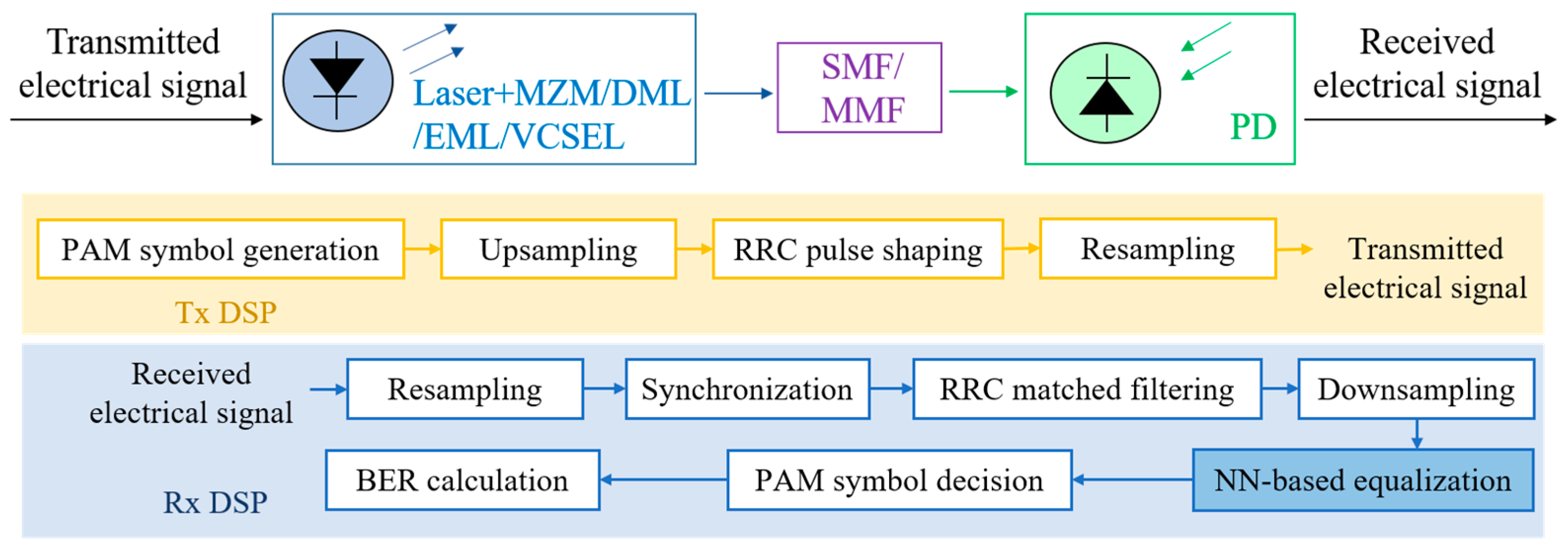
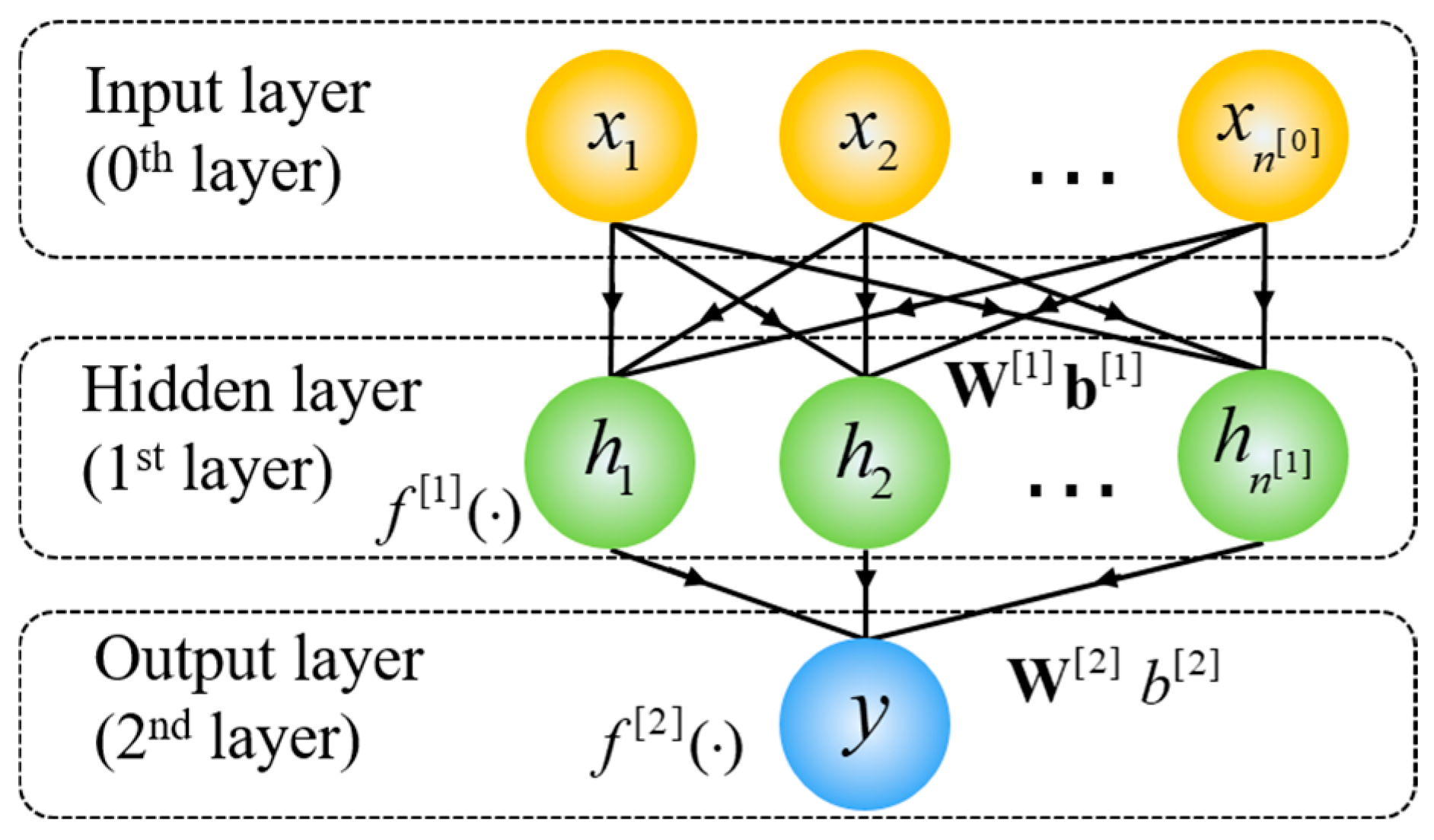
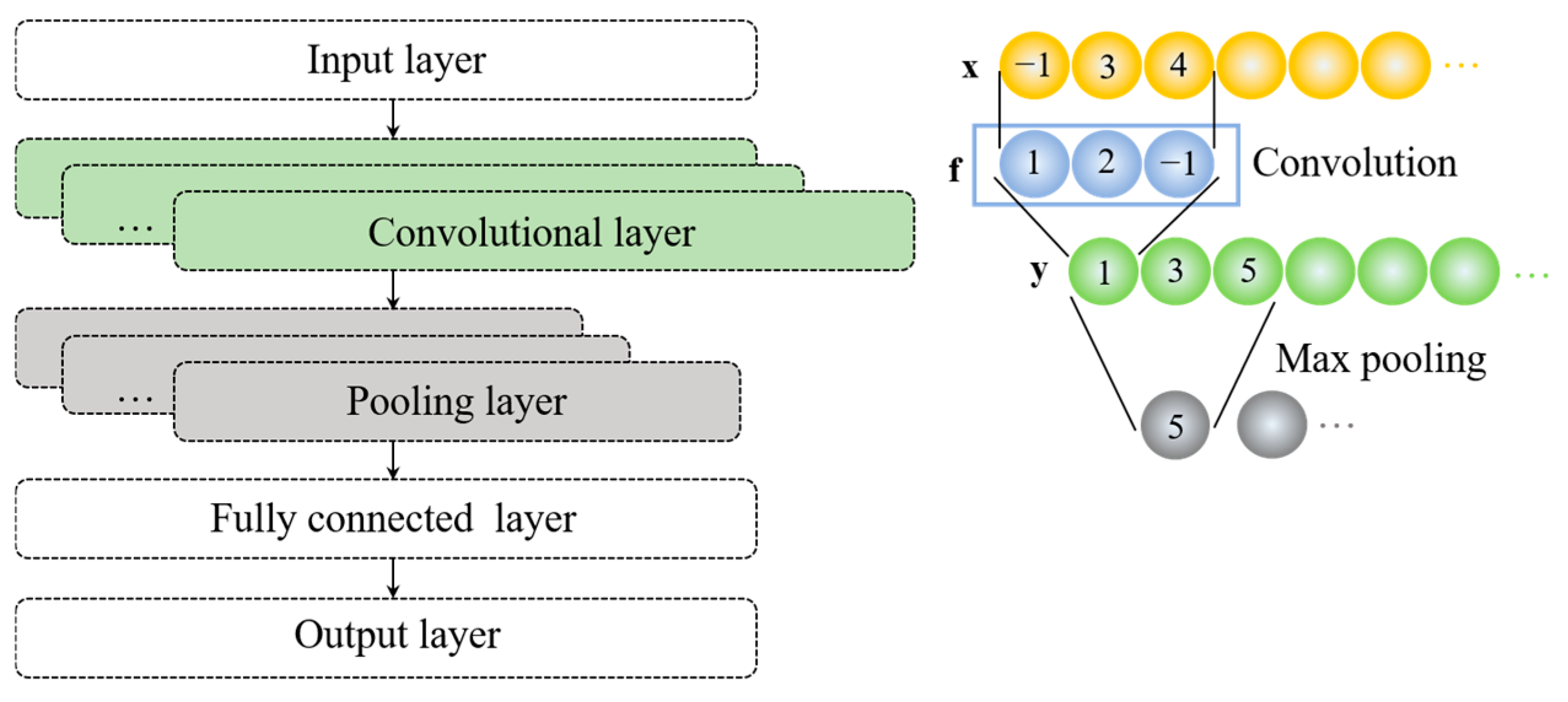
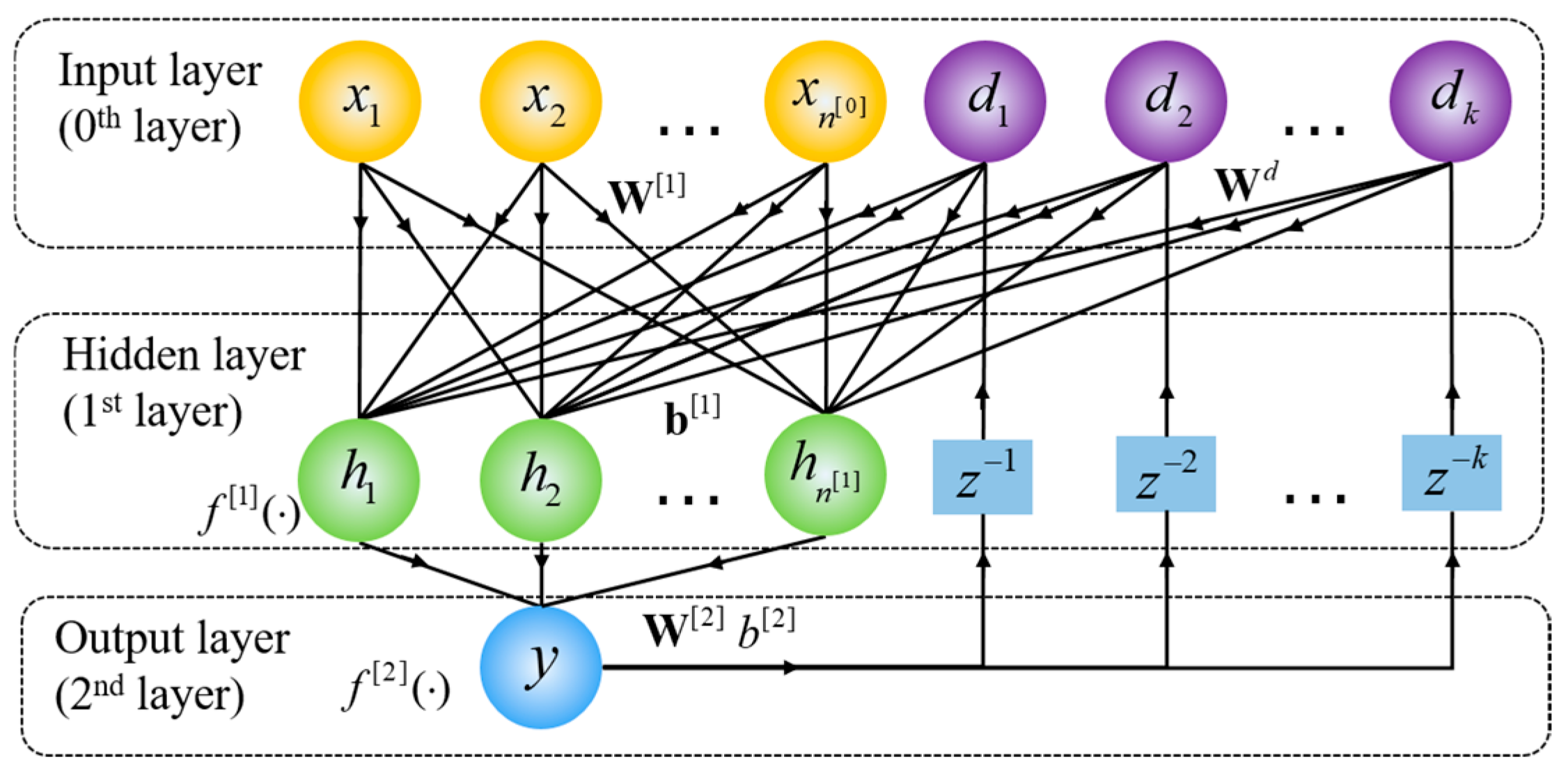
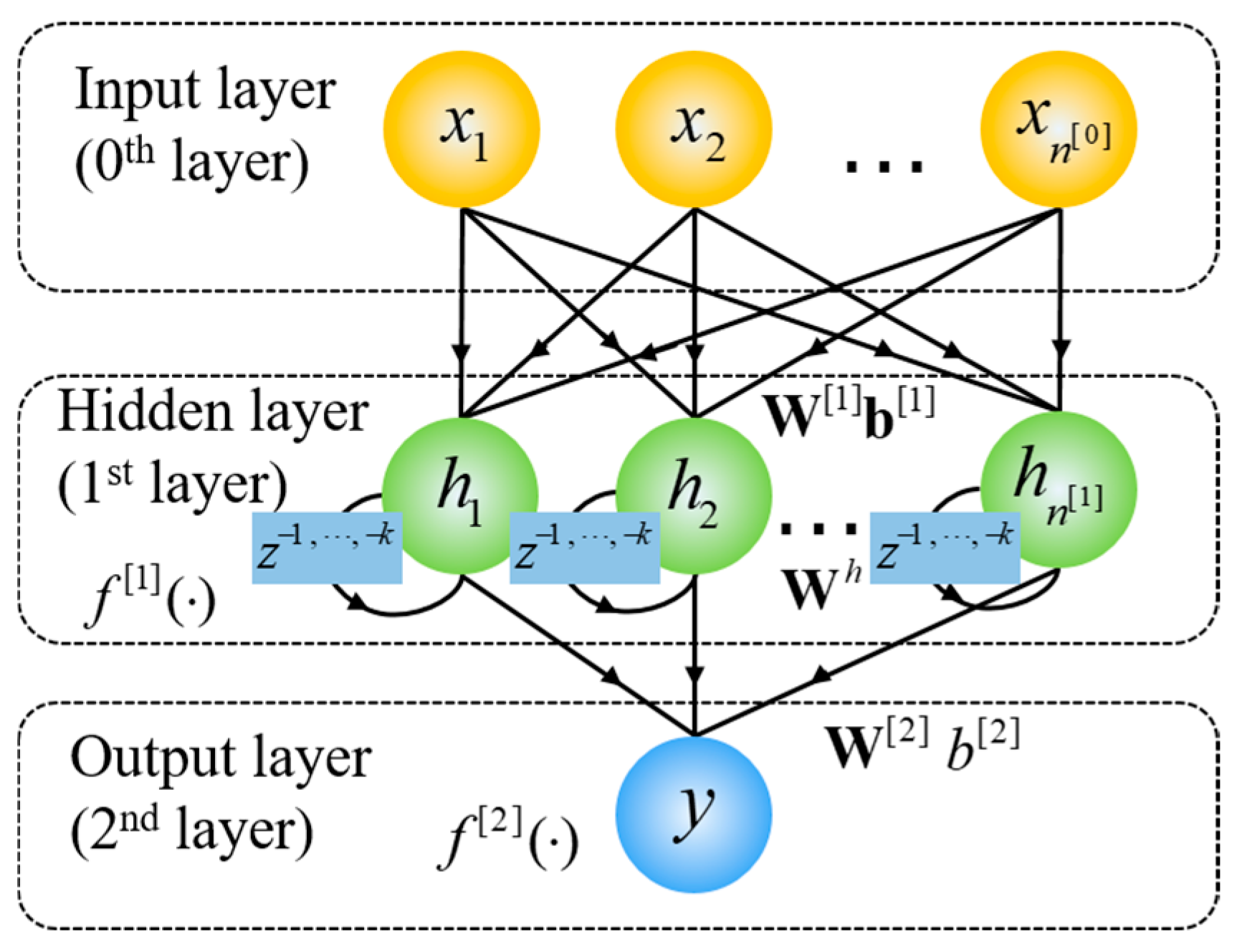
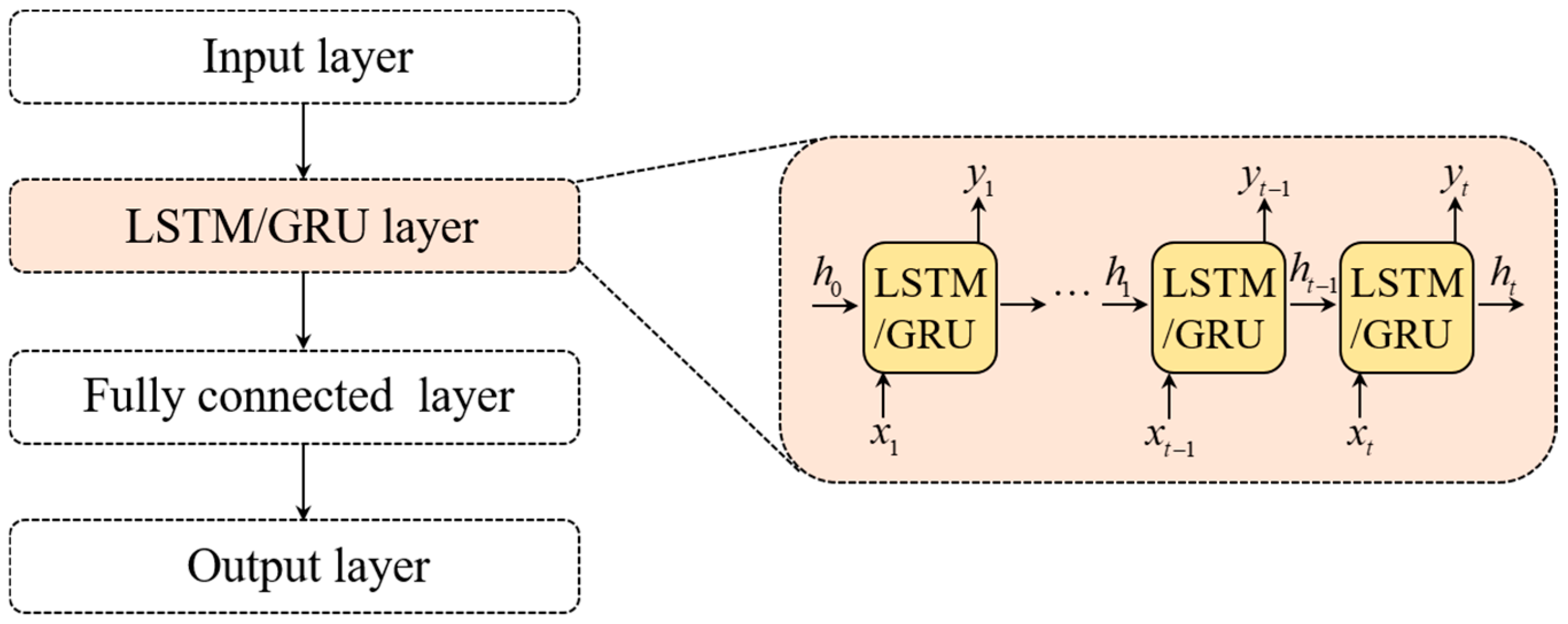
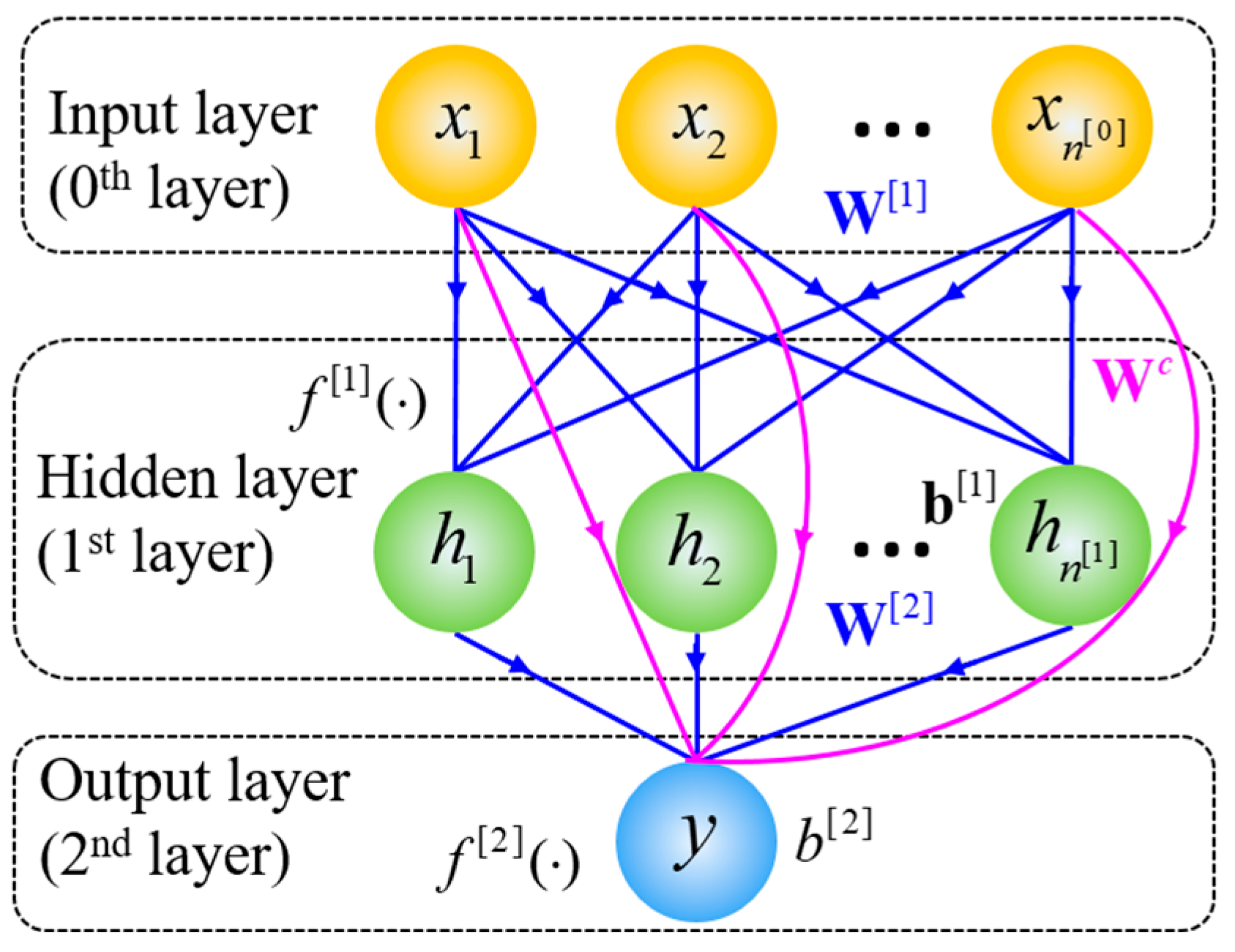
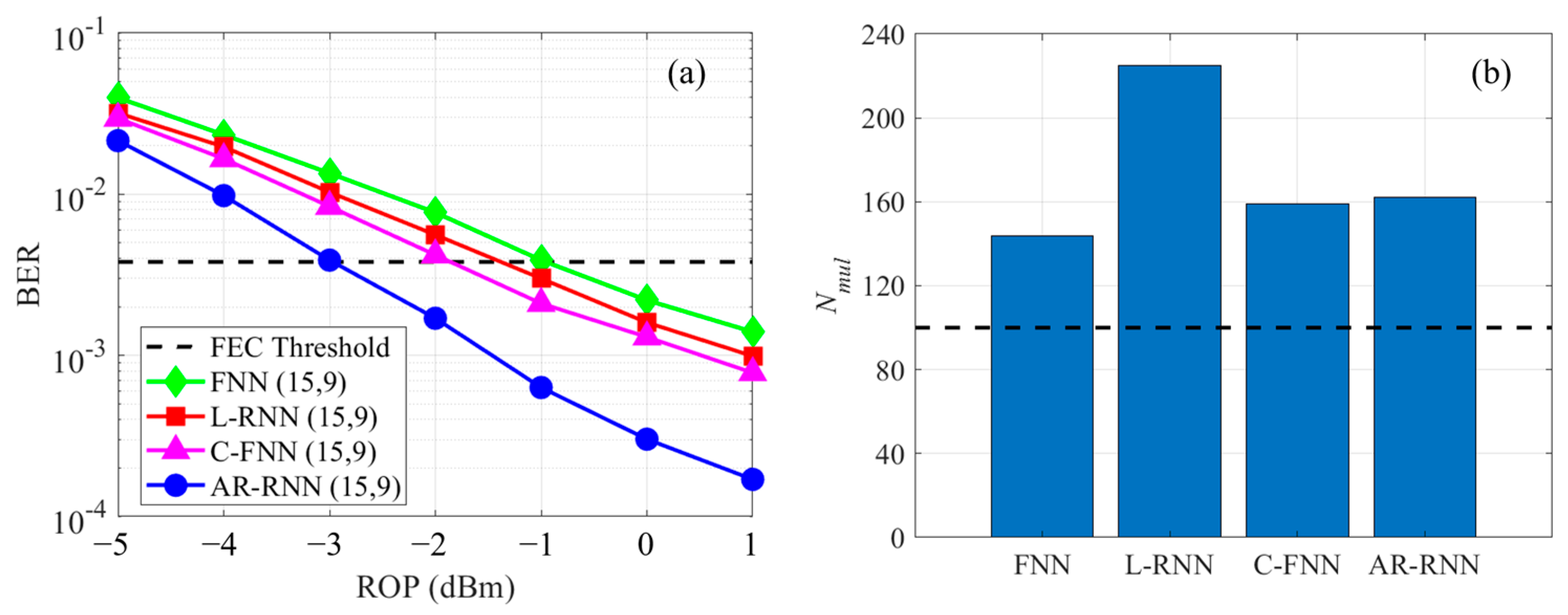
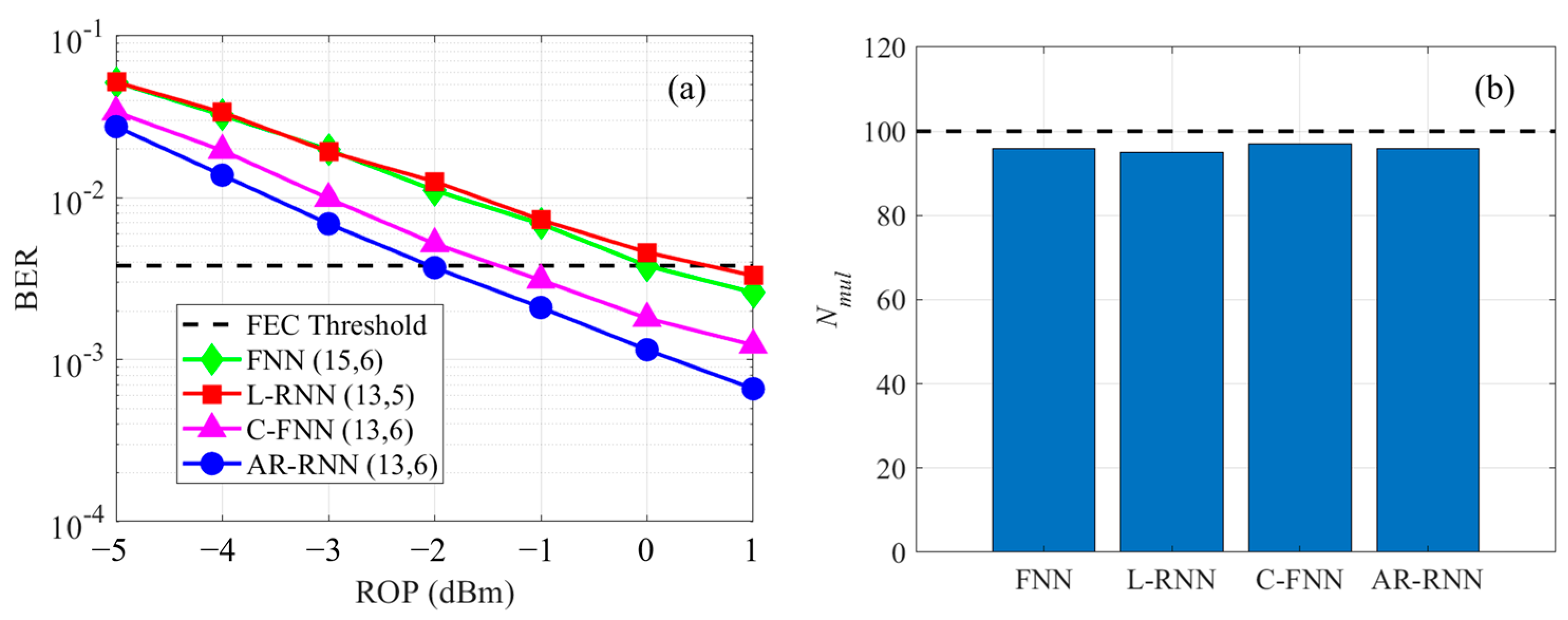

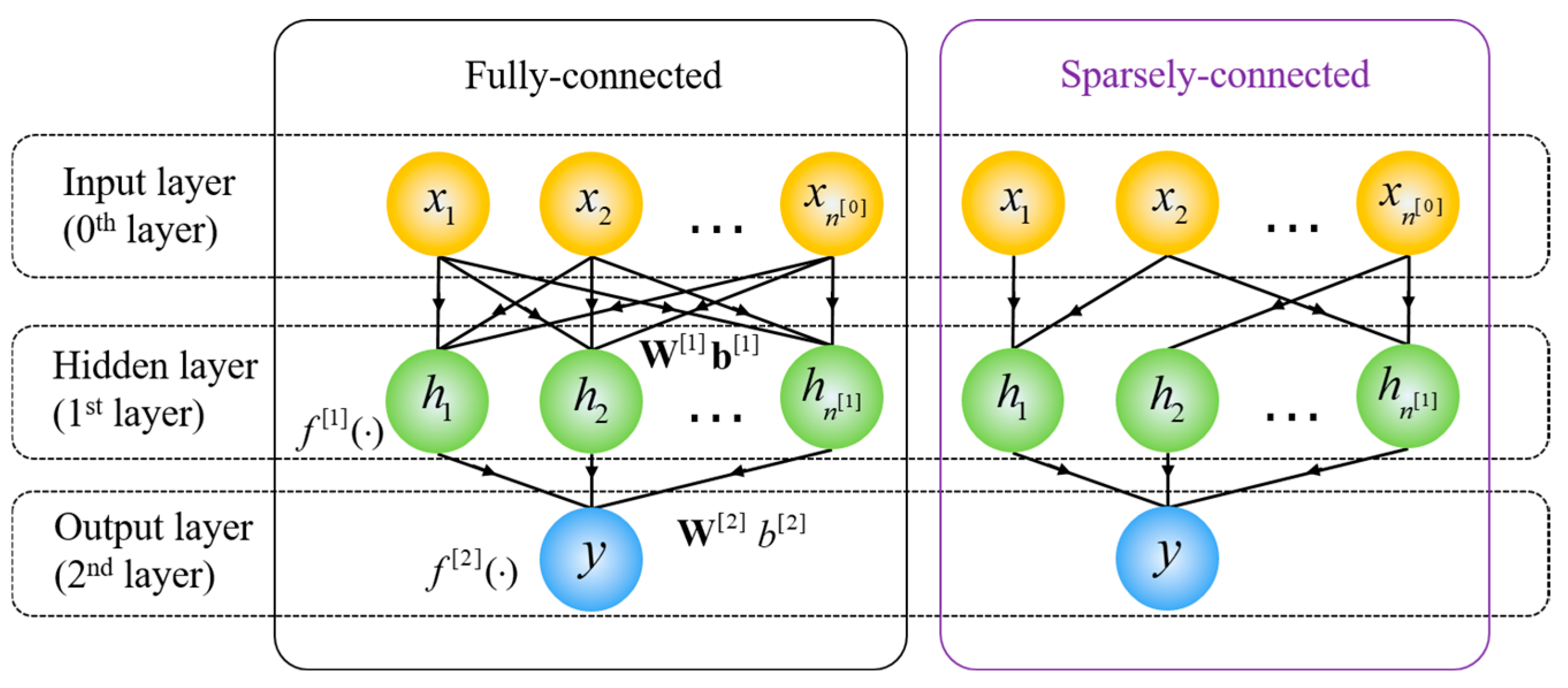

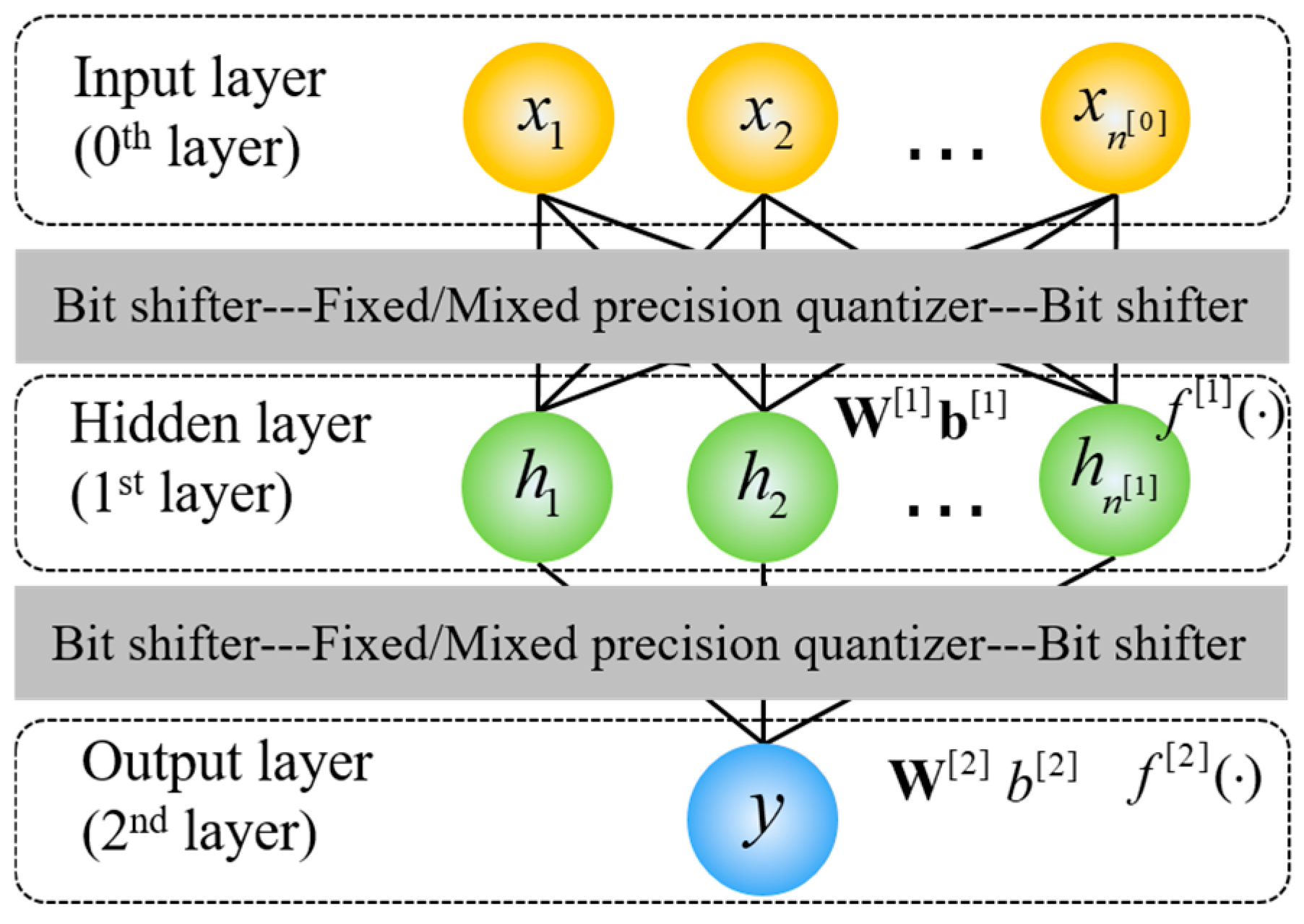
| NN Type | Ref. | Modulation | Data Rate | Fiber Length | Tx Type | Wavelength |
|---|---|---|---|---|---|---|
| FNN | [95] | PAM4 | 168 Gb/s | 1.5 km SMF | MZM (35 GHz) | ~1550 nm |
| [96] | PAM4 | 64 Gb/s | 4 km MMF | VCSEL (25 GHz) | ~850 nm | |
| [97] | PAM4 | 50 Gb/s | 20 km SMF | MZM (10 GHz) | ~1550 nm | |
| [98] | PAM4 | 20 Gb/s | 18 km SMF | DML (10 GHz) | ~1310 nm | |
| [99] | PAM2/PAM4/PAM8 | 54 Gb/s | 25 km SMF | DML (10 GHz) | ~1550 nm | |
| [100] | PAM4 | 4 × 50 Gb/s | 80 km SMF | DML (20 GHz) | ~1550 nm | |
| [101] | PAM4 | 137 Gb/s | 40 cm MMF | MZM (25 GHz) | ~850 nm | |
| [102] | PAM4 | 112 Gb/s | 100 m MMF | VCSEL (NA) | ~850 nm | |
| [103] | PAM4 | 50 Gb/s | 20 km SMF | DML (10 GHz) | ~1310 nm | |
| [104] | PAM2 | 50 Gb/s | 30 km SMF | MZM (35 GHz) | ~1310 nm | |
| [105] | PAM4 | 160 Gb/s | 2 km SMF | GeSi EAM (30 GHz) | ~1550 nm | |
| [106] | PAM4 | 56 Gb/s | 20/30/40 km SMF | MZM (40 GHz) | ~1550 nm | |
| CNN | [107] | PAM4 | 112 Gb/s | 40 km SMF | EML (25 GHz) | ~1310 nm |
| [108] | PAM4 | 56 Gb/s | 25 km SMF | DML (10 GHz) | ~1310 nm | |
| [109,110] | PAM8/PAM16 | 100 Gb/s | 25 km SMF | DML (20 GHz) | ~1310/1550 nm | |
| [111] | PAM4 | 56 Gb/s | 100 km SMF | MZM (40 GHz) | ~1550 nm | |
| RNN | [112] | PAM2/PAM4 | 60/100 Gb/s | 20 km SMF | MZM (40 GHz) | ~1550 nm |
| [113,114] | PAM4 | 100 Gb/s | 20 km SMF | MZM (NA) | ~1310 nm | |
| [115] | PAM4 | 56 Gb/s | 100 m MMF | VCSEL (18 GHz) | ~850 nm | |
| [116] | PAM8 | 288 Gb/s | 100 m MMF | VCSEL (23 GHz) | ~850 nm | |
| [117] | PAM4 | 50 Gb/s | 100 km SMF | DML (18 GHz) | ~1550 nm | |
| [118,119] | PAM4 | 160 Gb/s | 1 km SMF | Si MRM (47 GHz) | ~1550 nm | |
| [120] | PAM8 | 270 Gb/s | 1 km SMF | Si MRM (55 GHz) | ~1550 nm | |
| [121,122] | PAM4 | 212 Gb/s | 1 km NZDSF | EML (40 GHz) | ~1550 nm | |
| [123,124] | PAM4 | 100 Gb/s | 5.4 km SMF | MZM (NA) | ~1550 nm | |
| Cascade NN | [125,126] | PAM4 | 50/100 Gb/s | 25/15 km SMF | DML (16 GHz) | ~1550 nm |
| [127] | PAM4 | 100 Gb/s | 4.8 km SMF | MZM (33 GHz) | ~1550 nm | |
| RBF-NN | [128] | PAM4 | 4 × 50 Gb/s | 80 km SMF | DML (18 GHz) | ~1550 nm |
| SNN | [129,130] | PAM4 | 224 Gb/s | 4 km SMF | NA | ~1270 nm |
| [131,132] | PAM4 | 100 Gb/s | 2 km SMF | NA | ~1310 nm | |
| [133] | PAM4 | 200 Gb/s | 5 km SMF | NA | ~1270 nm |
Disclaimer/Publisher’s Note: The statements, opinions and data contained in all publications are solely those of the individual author(s) and contributor(s) and not of MDPI and/or the editor(s). MDPI and/or the editor(s) disclaim responsibility for any injury to people or property resulting from any ideas, methods, instructions or products referred to in the content. |
© 2024 by the authors. Licensee MDPI, Basel, Switzerland. This article is an open access article distributed under the terms and conditions of the Creative Commons Attribution (CC BY) license (https://creativecommons.org/licenses/by/4.0/).
Share and Cite
Xu, Z.; Ji, T.; Wu, Q.; Lu, W.; Ji, H.; Yang, Y.; Qiao, G.; Tang, J.; Cheng, C.; Liu, L.; et al. Advanced Neural Network-Based Equalization in Intensity-Modulated Direct-Detection Optical Systems: Current Status and Future Trends. Photonics 2024, 11, 702. https://doi.org/10.3390/photonics11080702
Xu Z, Ji T, Wu Q, Lu W, Ji H, Yang Y, Qiao G, Tang J, Cheng C, Liu L, et al. Advanced Neural Network-Based Equalization in Intensity-Modulated Direct-Detection Optical Systems: Current Status and Future Trends. Photonics. 2024; 11(8):702. https://doi.org/10.3390/photonics11080702
Chicago/Turabian StyleXu, Zhaopeng, Tonghui Ji, Qi Wu, Weiqi Lu, Honglin Ji, Yu Yang, Gang Qiao, Jianwei Tang, Chen Cheng, Lulu Liu, and et al. 2024. "Advanced Neural Network-Based Equalization in Intensity-Modulated Direct-Detection Optical Systems: Current Status and Future Trends" Photonics 11, no. 8: 702. https://doi.org/10.3390/photonics11080702
APA StyleXu, Z., Ji, T., Wu, Q., Lu, W., Ji, H., Yang, Y., Qiao, G., Tang, J., Cheng, C., Liu, L., Wang, S., Liang, J., Sun, Z., Fan, L., Wei, J., & Shieh, W. (2024). Advanced Neural Network-Based Equalization in Intensity-Modulated Direct-Detection Optical Systems: Current Status and Future Trends. Photonics, 11(8), 702. https://doi.org/10.3390/photonics11080702








